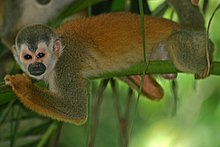Saimiri Wildlife
Saimiri Wildlife is a nature conservation organization that tries to protect the Central American squirrel monkey ( Saimiri oerstedii ) from extinction by reforesting species-rich rainforests in Panama . The organization, led by biologists and forest engineers , is based in Panama and Germany.
Saimiri Wildlife uses a newly developed method for afforestation. The surface is first for about a year as a wasteland left alone. Spontaneous vegetation develops - a typical ruderal vegetation with little biodiversity - which, if there is no grazing and no slash and burn, usually consists of a few grasses, herbaceous plants and some low shrubs. In conventional reforestation work, this form of vegetation is laboriously removed to make space for the selected plants. However, it is ecologically more sensible and also cheaper to include this spontaneous vegetation in the planned reforestation, because it can provide detailed information about the soil conditions and indicate drought or moisture reserves in the soil; The plantings can be carried out later in a more targeted manner and adapted to the soil conditions. Many rainforest trees also prefer shady conditions when they are young. If such trees can be planted in the shade of bushes, they will develop faster and withstand dry periods better. Fewer young plants are also needed because not as many plants fail.
Saimiri Wildlife started its work in 2006 with the purchase of a first project area. The reforestation concept makes it possible to create species-rich new forests on the protected areas, which can be used again as habitat by the squirrel monkeys within just two years.
Climate protection through afforestation
Around 1000 tons of carbon dioxide are stored in soil and biomass per hectare of tropical rainforest . In addition, the vegetation of each hectare binds around 15 to 20 tons of carbon dioxide per year (for comparison: this corresponds approximately to the amount of carbon dioxide that is released per capita and year in industrialized countries). Renewable forests in particular have a high rate of carbon fixation. In addition to this globally important climate protection, extensive reforestation also stabilizes the regional climate. Forest can absorb large amounts of precipitation and later release it evenly over a longer period of time. This lowers the risk of flooding and reduces the risk of periods of drought. The evaporation promotes the formation of clouds, which prevents extreme temperature maxima and generates new precipitation.
Web links
- saimiri.org Saimiri Wildlife website
